All Saints’ Anglican Church
Flinders Street, Albion Park
Unknown builder (English), c.1860-80
Installed in this location 1953 from a church in Bermondsey, London, UK
Removed to storage 2008 Mark Fisher, Sydney
Undergoing restoration at Dural 2017-18 Peter Johnston and Toby Jackson
1 manual, 4 speaking stops, no pedals, mechanical action
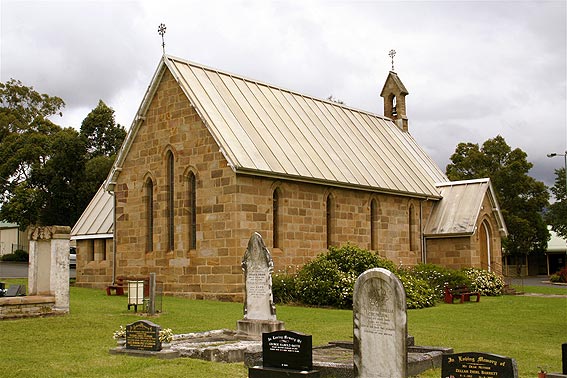
All Saints' Anglican Church, Albion Park
[Photograph by Trevor Bunning (November 2007)]
Historical and Technical Documentation by Kelvin Hastie
and Geoffrey Cox
© OHTA 1979, 2023 (last updated October 2023)
All Saints' Church, Albion Park, was opened and consecrated by The Rt. Rev. Frederick Barker, Anglican Bishop of Sydney, on 8 December 1875:
THE NEW CHURCH OF ENGLAND, MACQUARIE RIVER
The opening and consecration of the new Episcopal Church at Macquarie River, or Albion Park, took place on Wednesday last . . . the Church is a very neat and handsome stone structure, with shingled roof, its dimensions being 23 by 53 feet. Its seating capacity will afford accommodation to a congregation of about 150 persons.1
Designed in restrained Gothic Revivalist style, the building was constructed using local sandstone quarried at Yellow Rock. Bishop Barker reputedly drew up and provided plans and specifications himself, but the architect is recorded as Edmund Blacket (1817-1883) of Sydney.2

All Saints' Anglican Church, Albion Park
[Photograph by Trevor Bunning (November 2007)]

The anonymous nineteenth-century organ at Albion Park
[Photograph by Trevor Bunning (November 2007)]
The pipe organ installed in October 1953 was the gift from a bombed out church in Bermondsey, London, UK, having been supplied by N.P. Mander, who also carried out some renovation prior to its export to Australia.3 At the time of its installation at Albion Park, there was speculation that it was built by J.C. Bishop of London, but it has more recently been attributed to Henry Bevington.
BEAUTY OF SOUND COMES FROM OLD LONDON DOCKSIDE CHAPEL
Sweet-Toned Organ Survived BombingBeauty and mellow tone have come to Albion Park from the drab surroundings of a disused chapel in a London dockside slum. This has happened by the installation of an organ - probably the smallest in Australia - at All Saints' Church.
The instrument was bought from a firm who acquired it from a disused chapel in the dockland district of Bermondsey - close to Tower Bridge - which was badly battered by bombing during the war.
The organ is about 100 years old and was probably made by the famous maker J. C. Bishop.
In a note on the organ the Rector, the Rev. V. A. Evans, says "There are only four ranks of pipes. These are on a small scale, beautifully fashioned and gently voiced, and produce a very sweet and mellow tone."
The cost was about a quarter of that for a new instrument and the money was raised by donations and a major effort by the Women's Guild.4

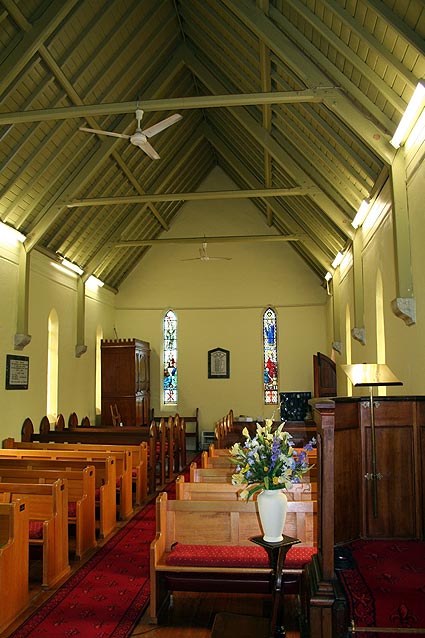
The organ located in the Albion Park church
[Photographs by Trevor Bunning (November 2007)]
The organ was dedicated at Albion Park on Wednesday 21 October 1953 by Archbishop H.W.K. Mowll, Anglican Primate of Australia:
ARCHBISHOP DEDICATES CHURCH ORGAN
The Primate of Australia, Archbishop H. W. K. Mowll, visited Albion Park on Wednesday last week to dedicate the pipe-organ which had been brought from England.
All Saints' Church was filled for the service which, in the absence of the Rector, was conducted by Archdeacon Begbie, Rector of Wollongong.
Following the dedication by the Primate, the Rev. N. Chynoweth, who came from Sydney for the occasion, played works by Bach and Guilmant.
In his address the Archbishop said he found deep pleasure in being able to dedicate "the sweet-toned instrument which had survived the hazards of war to find a new home in another land."5
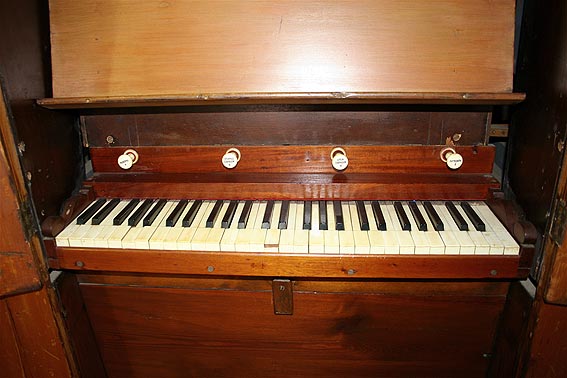


Console details of the organ at Albion Park
[Photographs by Trevor Bunning (November 2007)]
The specification of the organ is:
| Manual Open Diapason Stopped Diapason Principal Fifteenth |
8 8 4 2 |
(to Tenor C) |
(no pedals)
Mechanical action
Unenclosed
Compass 54 notes.6
The instrument is of unknown provenance, but has as its basis an English nineteenth-century organ of the period 1860-80, with quite an amount of replacement pipework.
The pipes in the lowest half of the Open Diapason 8ft TC have two sets of engravings: the lowest octave has been carefully lengthened and were originally a Principal, while the next octave-and-a-half came from a Twelfth. The engravings on the Principal 4ft, on the other hand, are consistent, and there are only a couple of replacement pipes in the Fifteenth 2ft. The wooden pipes of the Stopped Diapason 8ft, being a good fit in this compact organ, also appear to be original.7
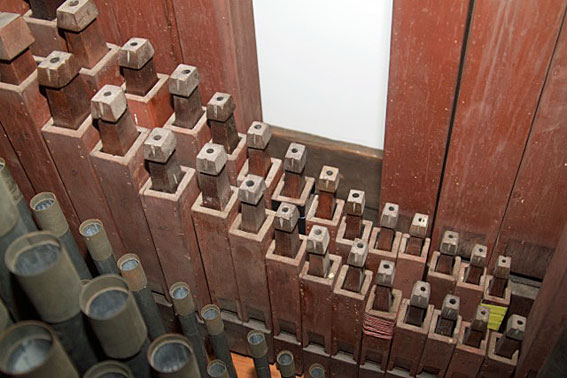
Pipework of the organ
[Photograph supplied by Peter Johnston (February 2018)]
The Albion Park instrument was removed to storage by in the workshop of Mark Fisher of Pipe Organ Reconstructions Pty Ltd, Sydney, in 2008, and was still awaiting restoration in 2016 around the time of his impending retirement.8 Fisher entrusted its care to two of his employees, Peter Johnston and Toby Jackson.
Following an unsuccessful attempt to offer the instrument to the Seventh-Day-Adventist Church at Wahroonga, it was decided to house it temporarily in the residence of Peter Johnston at Dural, where restoration work could continue at a leisurely pace. Owing to the ceiling height, the organ has been set up without casework, which has been carefully stored in an adjacent room. Two temporary off-note chests have been constructed for the eight longest pipes, which would not fit underneath the ceiling.9
The organ is now dismantled and stored at the workshop of Hargraves Pipe Organs Pty Ltd, Mt Evelyn, Victoria.



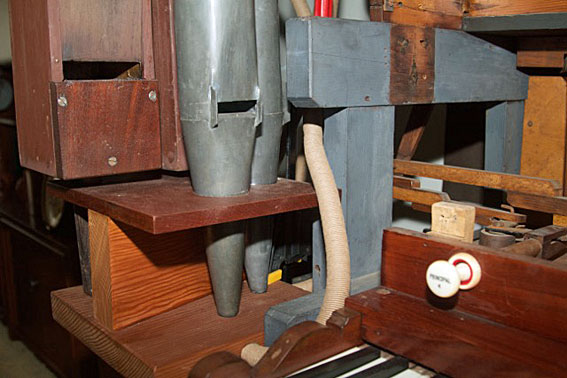
The organ during restoration at Dural, NSW
[Photographs supplied by Peter Johnston (February 2018)]
At some point in its history, the organ had been fitted with a (non-original) 18-note pedalboard with a set of backfalls and stickers, and the whole instrument had been raised on a rather crude pedestal to allow for this. As the pedalboard and action had not been extant for quite some time, the pedestal has been removed and stored, thus lowering the organ to its original height. The original double-rise reservoir remains functional, and the wind pressure has been set to 2.5 inches, following a pencil inscription on the soundboard. The pitch is approximately 444Hz at 23deg.C.10


Console details during restoration at Dural, NSW
[Photographs supplied by Peter Johnston (February 2018)]
_______________________________________________
1 Illawarra Mercury (10 December 1875), p. 2.
2 NSW State Heritage Inventory, cited February 2018 at http://www.environment.nsw.gov.au/heritageapp/ViewHeritageItemDetails.aspx?ID=2380015
3 Church of England Historical Society Journal (September 1969), cited in NSW State Heritage Inventory, loc. cit.
4 Kiama Independent (31 October 1953), p. 6.
5 Kiama Independent, loc. cit; see also: Illawarra Daily Mercury (17 October 1953), p. 2.
6 Specification noted by Kelvin Hastie, 1 September 1979.
7 Personal communication to Geoffrey Cox from Peter Johnston, March 2018.
8 'Three Bevington Organs for Disposal,' OHTA News, vol. 40, no. 3 (July 2016), pp. 8-9.
9 Personal communication to Geoffrey Cox from Peter Johnston and Toby Jackson, February 2018.
10 Loc. cit.